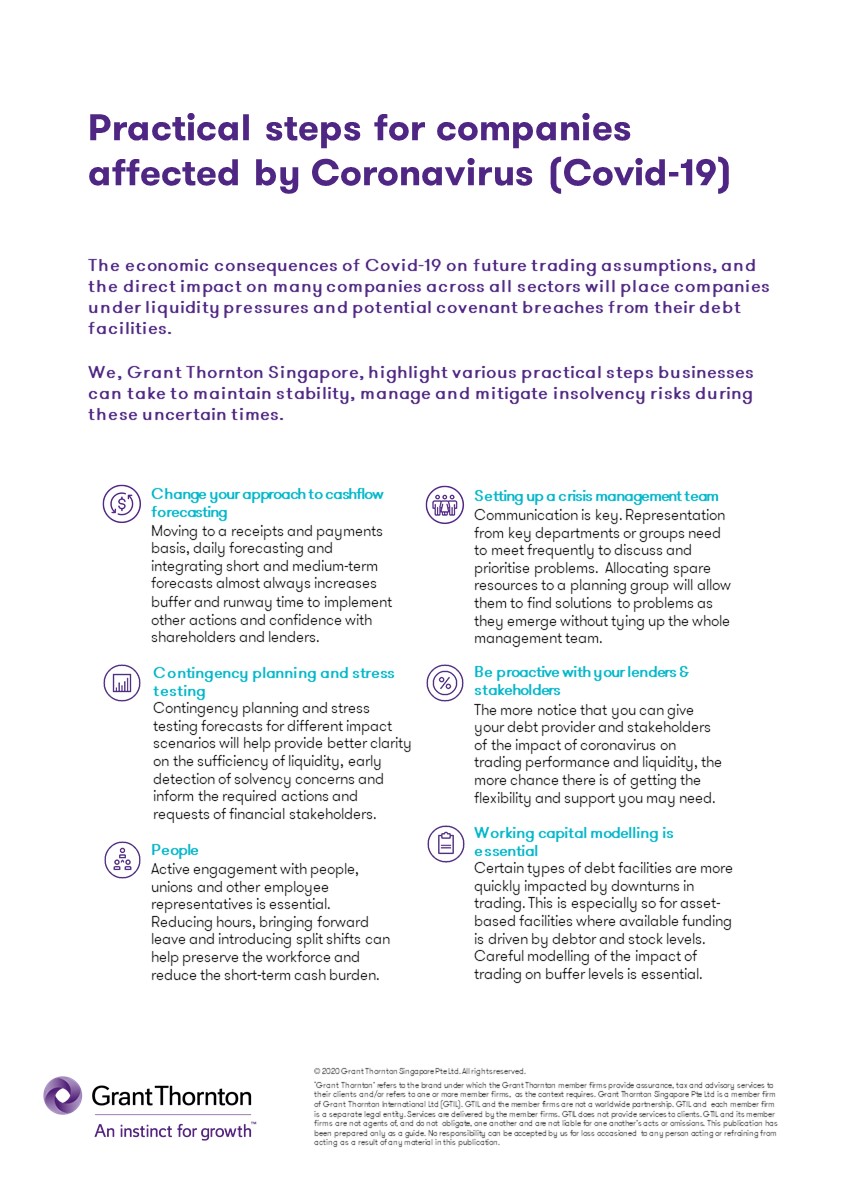The economic ramifications of the COVID-19 pandemic are huge, diverse and far-reaching. When uncertainty is the new norm, standing still isn’t an option.
To help you respond to what is happening now and plan for what is next, we have summarised the five areas you will need to focus on during this unprecedented time:
Cash management
- Managing creditors’ payments – i.e. working capital management, consider what your business can achieve through internal disciplines
- Change your approach to cashflow forecasting – i.e. moving to a receipts and payments basis, consider daily cashflow forecasting
- Negotiate payment deferrals – particularly, for example, with landlords, banks and other key stakeholders who are critical to your business’ success
- Discounts on supplies (although we note that this is likely to have less cash flow benefit in the short-term)
- Sweep idle cash from other facilities into the working capital account, or draw down on available banking facilities, so they are accessible to fund critical business needs
- Negotiate with customers to pay early, offer a discount (this is the flipside of the above point regarding supplier payments, and can be a challenge in the current environment, but should be explored)
- Tax concessions – i.e. waivers, deferral of taxes
Contingency planning
- Supply chain – Consider stockpiling on essential supplies, ensure alternative sources are identified
- Establish staff support plans to allow them to continue working (ie childcare, flexible working, remote working)
- What reliance does your business have on external support for any business processes/interaction with other businesses (including the supply/delivery chain)?
- Review for alternate sources of support to allow for loss of business support functions
- Identify alternate delivery mechanisms, including storage, deferred delivery/production agreements
- Consider whether part (or all) of your business should be suspended, and the implications (e.g. non-compliance with legal obligations and covenants, activation of the force majeure clauses, etc.) in terms of deactivating equipment and dealing with live projects or work in progress.
- Prepare any necessary steps, announcements or resources necessary to implement the plan if called on at short notice
Stakeholder management
- See earlier points on cash management and the need for a sound contingency plan to present to key stakeholders. If your business is not proactive in engaging with tax authorities, lenders, landlords and key suppliers then your competitors will be. Businesses risk missing out on financial and other support if they don’t engage early with a plan
People
- Many businesses are facing a shut down or slow down. This is likely to last a minimum of three months and possibly six months before the business even starts to rebuild again. We need to understand the profile of the workforce:
- Full time or part time or shortened hours of contractors – there is less flexibility providing options for full time employees
- Are they unionised or subject to contractual arrangements which may limit options?
- Has your business implemented flexible working options? What will prevent this occurring?
- The current circumstances are unprecedented in our working lives and all parties will have a vested interest to keep the businesses alive and to preserve employment. Therefore, reduced hours, bringing forward leave, split shifts and other measures that can preserve the workforce for a period of time, but also reduce the short-term cash burden, could be the difference between survival or otherwise
- Set a clear policy for people absence, covering voluntarily absence and for situations where people are quarantined or unwell
Setting up a crisis management team
- Ensure representatives from key departments or groups meet frequently to discuss and prioritise the problems
- Wherever possible, try to anticipate the next problem
- If you have spare resources, allocate some of them to a ‘hot planning’ group who can react and find solutions to individual problems as they emerge without tying up the whole management team
- Communicate early, often and frankly with the team – establish a communication system which can reach staff at home or otherwise isolated. Lack of news breeds uncertainty and concern
We hope this information is helpful for your business continuity planning. Such planning is designed to bring a sense of purpose to your actions in the event of an unforeseen calamity and greatly increases the odds for your company’s continued survival and success.
Please do not hesitate to get in touch with us to discuss any of the above or if we can assist you or your organisation in any way.







